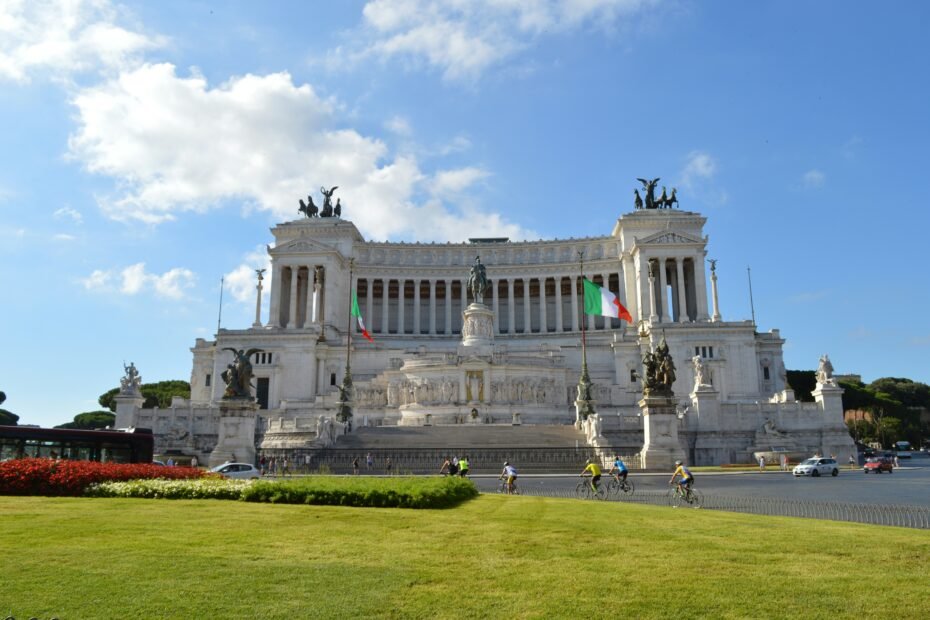Piazza Venezia is one of Rome’s most important and bustling squares, serving as a central hub for both historical exploration and modern city life. Here’s a comprehensive guide to help you as a tourist:
Historical Background
- Name Origin: The square is named after Palazzo Venezia, a Renaissance palace built by Cardinal Pietro Barbo (later Pope Paul II) in the 15th century.
- Central Role: Piazza Venezia has long been a crossroads of Roman life, connecting ancient, medieval, and modern landmarks.
- Fascist Era: It became famous as a focal point for Mussolini’s speeches during the Fascist period in the 20th century.
Architectural Highlights
- Altare della Patria (Altar of the Fatherland)
- Also known as the Vittorio Emanuele II Monument or simply “The Wedding Cake” due to its elaborate design.
- Built in honor of King Victor Emmanuel II, the first king of unified Italy.
- Features:
- A massive equestrian statue of Victor Emmanuel II.
- The Tomb of the Unknown Soldier, is guarded by an eternal flame and soldiers.
- Panoramic terraces offering spectacular views of Rome (accessible by elevator).
- Palazzo Venezia
- A Renaissance palace that once served as the papal residence and later as Mussolini’s headquarters.
- Today, it houses the National Museum of Palazzo Venezia, showcasing art and artifacts from the Middle Ages and Renaissance.
- Palazzo Bonaparte
- Located at the corner of the square, this building was the residence of Napoleon Bonaparte’s mother.
- Recently restored and often hosts art exhibitions.
- Trajan’s Forum and Column
- Adjacent to Piazza Venezia, these ancient Roman ruins are among the best-preserved and most significant in the city.
- The column depicts Emperor Trajan’s victory in the Dacian Wars through intricate relief carvings.
Activities and Attractions
- Explore the Altare della Patria
- Visit the museum inside the monument, dedicated to Italy’s unification and military history.
- Take the elevator to the terrace for breathtaking panoramic views of Rome, including the Colosseum, Roman Forum, and Vatican.
- Visit Palazzo Venezia Museum
- Admire the art collection, which includes Renaissance sculptures, ceramics, tapestries, and paintings.
- Walk to Nearby Landmarks
- Roman Forum: A short walk from the square.
- Capitoline Hill (Campidoglio): Designed by Michelangelo, this historic site is just steps away and includes the Capitoline Museums.
- Via del Corso: A major shopping street starts from the square.
- Photograph the Square at Night
- The Altare della Patria is beautifully illuminated, creating a dramatic scene.
Practical Information
- Opening Hours:
- Piazza Venezia itself is open 24/7.
- Museums and the Altare della Patria have specific opening hours (typically 9:30 AM–7:30 PM; check locally for updates).
- Admission:
- Access to the square is free.
- Fees apply for museum entry and the panoramic terrace elevator at the Vittorio Emanuele II Monument.
- Public Transport:
- Easily accessible via buses, trams, and Metro Line B (Colosseo station is nearby).
Tips for Tourists
- Best Times to Visit:
- Morning or late afternoon for fewer crowds and softer lighting for photography.
- Sunset for panoramic terrace views.
- Stay Alert:
- The square is very busy with vehicular and pedestrian traffic. Cross streets carefully.
- Combine Visits:
- Plan to visit Piazza Venezia as part of a walking tour of nearby landmarks like the Roman Forum, Colosseum, and Capitoline Hill.
- Wear Comfortable Shoes:
- The area around Piazza Venezia is best explored on foot, and many streets are cobblestoned.
Nearby Attractions
- Trevi Fountain: About a 10-minute walk.
- Pantheon: Approximately 15 minutes on foot.
- Jewish Ghetto and Largo di Torre Argentina: Within walking distance.
Fun Facts
- The Vittorio Emanuele II Monument is nicknamed “The Typewriter” due to its grandiose white marble design resembling a typewriter.
- Mussolini famously addressed crowds from the balcony of Palazzo Venezia during World War II.
- The square’s location makes it the heart of Rome, often the starting point for major parades and celebrations.
Cultural Significance
Piazza Venezia is more than just a transportation hub; it represents a crossroads of Roman history, connecting ancient ruins with modern political and cultural landmarks. Its vibrant atmosphere and central location make it an essential stop for anyone exploring the Eternal City.
